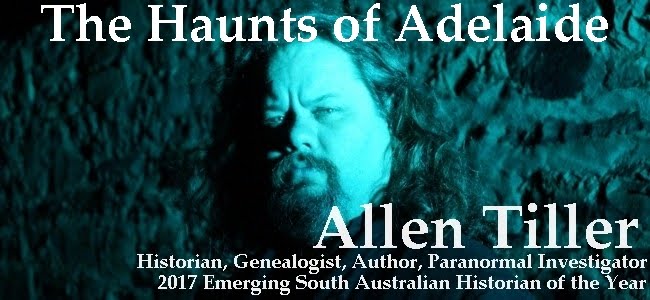Ghosts of the South Coast
Old Mount Gambier Gaol
Part 1
Recently my wife and I had the privilege of spending two nights in the Old Mount Gambier Gaol, and although nothing paranormal happened whilst we were present, there have been plenty of reported accounts of paranormal goings-on in the building in the recent past.
 |
| Border Watch, Tuesday 4 June 1946, page 14 |
What you are about to read below is taken from previous writings from my website at www.eidolonparanormal.com.au this is a brief account of the history and ghost stories. As I gather more information about the activities going on in the Gaol complex I will post a more definitive review on the paranormal relationship of ghosts and guests, until then, enjoy this brief write up!
History
The Old Mount Gambier Gaol was completed in 1866 after a need for a gaol in the southern regions of South Australia become an issue.
The Gaol in Robe was insufficient and poorly built (only being open for ten years), and the Government at the time saw Mount Gambier as the next best location, and a more central place to build a gaol that would alleviate the issue of travel to Adelaide for inmates and Police officers.
The Gaol's first Keeper was George Tims.
A list of Keepers of Mount Gambier Gaol includes:
B. Young – 1884
D. Plunkett – 1888
S. Criddle – 1896.
R. McDonald – 1911
R. Lowe – 1917
E. Conole – 1920
H.E. Langlois – 1935
T. Lashbrook – 1960
A. Binnie – 1962
J Moody – 1963
G. Bullock – 1974
R.J Stratman – 1979 – until the Gaols closure in 1995
The Gaol has a long history of corporal punishment and hard labour, even unto children who were arrested and sentenced. One child, John MacMasters, a 13-year-old boy, was sentenced to Gaol for 18 months for forgery, where he would be inside with adult men, but to add more pain to his infliction, the judge also sentenced the boy to be flogged with 20 lashes in the last week of his stay at the gaol.
However, mercy was on the boy's side when the women of the local town heard of his plight and petitioned the Governor, who then spared the boy the flogging.
.JPG) |
| Where the ghost of a lady in white is seen |
Mary Turley was not so lucky, she was caught stealing, and was on remand. Close to being imprisoned, her only saving grace, her Father, who offered to give her a “severe whipping” for her crime. The judge allowed the Fathers punishment and released the girl into his custody.
The Gaol saw death greet some of its prisoners. Suicide is the main account of death, usually by hanging. The first death by suicide was of an Aboriginal girl named Eliza Walton, on the 19th of January 1867.
.JPG) |
| Two executed men are thought to be buried here |
In the life span of the gaols operating years, from 1866 to 1995, twelve people lost their lives inside the walls of Old Mount Gambier Gaol, 2 men were hung for their crimes, 5 people committed suicide by hanging, and 4 people lost their lives through natural causes.
The first execution in Mount Gambier Gaol happened on November 10th, 1871. Carl Jung, a shoemaker and wine seller of German origin had gone into debt because of poor sales. In June that year, bailiff, Thomas Garroway was sent to seize the goods and effects of Jung.
The two men came to an agreement, and Jung was to follow the bailiff into Mount Gambier the following day.
When morning broke and Jung joined Galloway to leave, the bailiff seized Jung's horse and cart, and some farm animals and set off for Mount Gambier.
Jung was furious and set off after him. When he finally caught the bailiff, he shot him with both barrels of his shotgun at close range.
Jung tried to kill himself but was unsuccessful, and fled into the scrub to hide, but hunger overtook him and he returned to his home, where the police were waiting and apprehended him.
Jung was hung inside the Gaol, holding a bouquet of flowers, that he asked to be given to his wife upon his death.
The next execution was that of William Page on the 27th of October 1875. Page was convicted for the brutal and gruesome strangling murder of Mary Buchan.
Page, also known as William Walker, had long deserted his wife and family and was wanted on desertion charges. He met Mary and courted her, he soon proposed (with a stolen ring), but kept delaying the wedding. Mary's parents urged her to end the relationship.
On Sunday the 11th of July 1875, Mary skipped Church to go for a walk with Page, her last walk on this Earth.
Her ending was pieced together by evidence given by Page, eyewitness accounts of Mary's whereabouts and Pathologist findings.
It is believed Mary went with Page, he pushed for sex, and Mary consented, but at the last minute refused, This angered Page, and an argument ensued, in which Mary returned the ring and refused marriage.
Page lost control and struck the girl with a whip with a metal tip on the end, Mary screamed uncontrollably from the pain, so Page grabbed her by the throat to quiet her, but killed her by doing so.
He buried her body and tried to hide the evidence of the crime, he then constructed an alibi, but he was already under suspicion, and when he tried to leave town was arrested.
Page pleaded guilty to his crimes of desertion, theft and murder and was duly sentenced and hung, at 8 am on the 27th of October 1875.
Next week we look into the final execution at the Gaol
© 2013 Allen Tiller
www.eidolonparanormal.com.au



.JPG)


.JPG)
.JPG)
.JPG)
.JPG)


.JPG)


.JPG)



